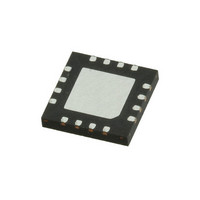MAX6694TE9A+ Maxim Integrated Products, MAX6694TE9A+ Datasheet - Page 12

MAX6694TE9A+
Manufacturer Part Number
MAX6694TE9A+
Description
IC TEMP MONITOR 5CH 16TQFN
Manufacturer
Maxim Integrated Products
Datasheet
1.MAX6694UE9A.pdf
(18 pages)
Specifications of MAX6694TE9A+
Function
Temp Monitoring System (Sensor)
Topology
ADC, Buffer, Multiplexer, Register Bank
Sensor Type
External & Internal
Sensing Temperature
-40°C ~ 125°C, External Sensor
Output Type
SMBus™
Output Alarm
Yes
Output Fan
Yes
Voltage - Supply
3 V ~ 3.6 V
Operating Temperature
-40°C ~ 125°C
Mounting Type
Surface Mount
Package / Case
16-TQFN Exposed Pad
Lead Free Status / RoHS Status
Lead free / RoHS Compliant
There are three read-write configuration registers
(Tables 4, 5, and 6) that can be used to control the
MAX6694’s operation.
The configuration 1 register (Table 4) has several func-
tions. Bit 7 (MSB) is used to put the MAX6694 either in
software standby mode (STOP) or continuous conver-
sion mode. Bit 6 resets all registers to their POR condi-
tions and then clears itself. Bit 5 disables the SMBus
timeout. Bit 3 enables resistance cancellation on chan-
nel 1. See the Series Resistance Cancellation section
for more details. Bit 2 enables beta compensation on
channel 1. See the Beta Compensation section for
more details. The remaining bits of the configuration 1
register are not used. The POR state of this register is
0000 1100 (0Ch).
The configuration 2 register functions are described in
Table 5. Bits 6, 3, 2, 1, and 0 are used to mask the
ALERT interrupt output. Bit 6 masks the local alert inter-
rupt and bits 3 through bit 0 mask the remote alert
interrupts. The power-up state of this register is 0000
0000 (00h).
Table 6 describes the configuration 3 register. Bits 3
and 0 mask the OVERT interrupt output for channels 4
and 1. The remaining bits, 7, 6, 5, 4, 2, and 1, are
reserved. The power-up state of this register is 0000
0000 (00h).
Status registers 1, 2, and 3 (Tables 7, 8, and 9) indicate
which (if any) temperature thresholds have been
exceeded and if there is an open-circuit or short-circuit
fault detected with the external sense junctions. Status
register 1 indicates if the measured temperature has
exceeded the threshold limit set in the ALERT registers
for the local or remote-sensing diodes. Status register 2
indicates if the measured temperature has exceeded
the threshold limit set in the OVERT registers. Status
register 3 indicates if there is a diode fault (open or
short) in any of the remote-sensing channels.
Bits in the alert status register clear by a successful
read, but set again after the next conversion unless the
fault is corrected, either by a drop in the measured tem-
perature or an increase in the threshold temperature.
The ALERT interrupt output follows the status flag bit.
Once the ALERT output is asserted, it can be
deasserted by either reading status register 1 or by
successfully responding to an alert response address.
5-Channel Precision Temperature Monitor
with Beta Compensation
12
______________________________________________________________________________________
Configuration Byte Functions
Status Register Functions
Configuration 1 Register
Configuration 2 Register
Configuration 3 Register
In both cases, the alert is cleared even if the fault condi-
tion exists, but the ALERT output reasserts at the end of
the next conversion. The bits indicating the fault for the
OVERT interrupt output clear only on reading the status 2
register even if the fault conditions still exist. Reading the
status 2 register does not clear the OVERT interrupt out-
put. To eliminate the fault condition, either the measured
temperature must drop below the temperature threshold
minus the hysteresis value (4°C), or the trip temperature
must be set at least 4°C above the current temperature.
The MAX6694 directly measures the die temperature of
CPUs and other ICs that have on-chip temperature-
sensing diodes (see the Typical Application Circuit ) or
it can measure the temperature of a discrete diode-
connected transistor.
The accuracy of the remote temperature measure-
ments depends on the ideality factor (n) of the remote
“diode” (actually a transistor). The MAX6694 is opti-
mized for n = 1.006 (channel 1) and n = 1.008 (chan-
nels 2, 3, and 4). A thermal diode on the substrate of an
IC is normally a pnp with the base and emitter brought
out to the collector (diode connection) grounded. DXP_
must be connected to the anode (emitter) and DXN_
must be connected to the cathode (base) of this pnp. If
a sense transistor with an ideality factor other than
1.006 or 1.008 is used, the output data is different from
the data obtained with the optimum ideality factor.
Fortunately, the difference is predictable. Assume a
remote-diode sensor designed for a nominal ideality
factor n
a diode with a different ideality factor n
temperature T
where temperature is measured in Kelvin and
n
an example, assume you want to use the MAX6694 with
a CPU that has an ideality factor of 1.002. If the diode
has no series resistance, the measured data is related
to the real temperature as follows:
T
NOMIMAL
ACTUAL
NOMINAL
=
T
for channel 1 of the MAX6694 is 1.009. As
M
M
×
T
⎛
⎜
⎝
M
Applications Information
can be corrected using:
n
is used to measure the temperature of
NOMINAL
=
T
n
ACTUAL
1
Remote-Diode Selection
Effect of Ideality Factor
⎞
⎟ =
⎠
⎛
⎜
⎝
T
n
M
NOMINAL
×
⎛
⎜
⎝
n
1 009
1 002
1
.
.
1
. The measured
⎞
⎟ =
⎠
⎞
⎟
⎠
T
M
( .
1 00699
)









